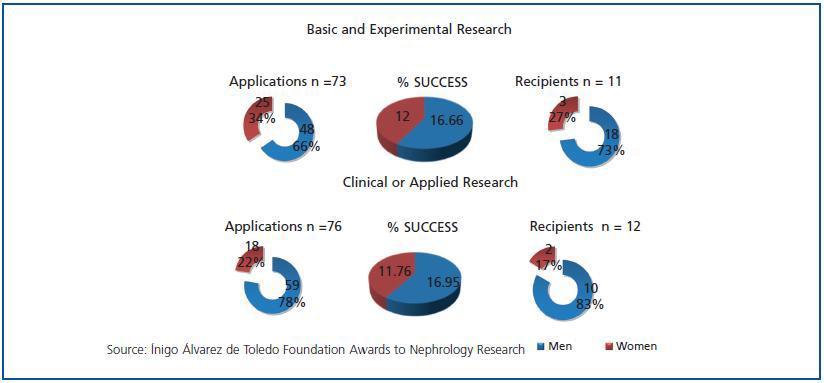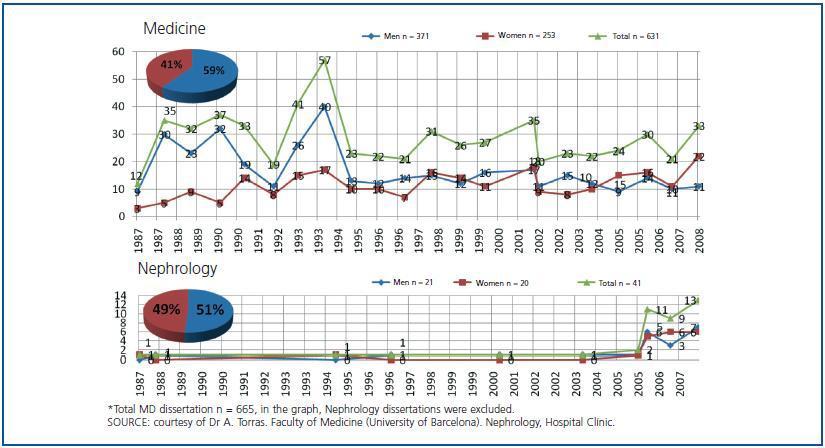Feminisation in nephrology is very high and their consequence in clinical research appears as an interesting focus. Nephrologist women participate to working groups and research projects of the Sociedad Española de Nefrología in similar percentage than they contribute to society, more or less 40%. Nephrologist women are half of medicine PhD. However, nephrologists women are represented the fifth part in advanced projects within clinical research. If the nephrology is a speciality which will be able to keep up with the increasing of the assistance demand, the participation of the women in the clinical research is basic. Without looking down on the other topics, the clinical research within epidemiology and quality about the renal health could be particularly attractive for the women in nephrology.
La nefrología es una de las especialidades médicas con mayor índice de feminización, lo que lleva a una reflexión sobre su repercusión en la investigación aplicada. Las nefrólogas participan en los grupos de trabajo y en proyectos de investigación de la Sociedad Española de Nefrología en la misma proporción en que contribuyen a la sociedad, alrededor del 40%, y son la mitad de los especialistas en nefrología que se han doctorado en medicina. Sin embargo, caen a la quinta parte en los proyectos de investigación clínica más avanzados. Si la nefrología es una de las especialidades mejor equilibradas para asumir el previsible aumento de la demanda asistencial a medio plazo, la participación femenina dirigida a la investigación clínica es fundamental. Sin ignorar otros focos de interés, los proyectos de investigación en los ámbitos de la epidemiología y de la calidad orientados a la salud renal pueden ser de particular atractivo para las nefrólogas.
INTRODUCTION
The field of medicine has experienced an increase in female participation greater than that of other professions. The influx of women in medical studies has been substantial since the 1970s in North America and the 1980s in Europe.1 In Spain, medicine is the most highly sought after field of study, there are about three applicants for each available university place. In spite of the numerus clausus in the 1980s leading to a 20% decline in enrolment, the profession has remained stable through an important increase in female presence, that amounted to 70% among newly enrolled students in the first years of the twenty-first century and that currently exceeds 85% of the student body. Among doctors who are Medical Association members, the percentage of women has increased 58.5% while that of men has barely increased 8.3% from 1997 to 2007.2
Nephrology is among the medical specialisations with the highest rates of feminisation, (43%).3 Some authors have claimed that nephrologists’ out of hours working time may suffer in the coming years because of socio-cultural factors stemming from the female condition.4 Given that nephrology has moulded itself around various findings in other medical specialties, it would be wise to reflect upon the consequences of feminisation and its repercussions on clinical research in nephrology.
MATERIAL AND METHODS
The admission registry and anonymous gender specific data related to participants in study groups and in Spanish Society of Nephrology’s (SEN) clinical guides was obtained.
Demographic data (anonymous and gender specific) related to participants in nephrology research was taken from the following organizations:
1. SEN: research grants to nephrology residents at foreign centres and Senefro Foundation (FS) research grants.
2. Iñigo Álvarez de Toledo Foundation (FIAT) basic and experimental research grants in nephrology and grants for clinical or applied research in nephrology
3. University of Barcelona (UB): Doctoral dissertations in Medicine.
RESULTS
In 1964, the year when SEN was founded, membership was 591 men and 103 women until 1983. From 1984 to 2008, male membership decreased 14% while female membership increased up to 600%. Therefore, of the 1,912 members in 2008, 1,099 were men (57%) and 813 were women (43%).
New male membership at SEN has barely amounted to a third of new female membership in the past four years, so 33 of the 38 research grants for work study in foreign medical centres have been awarded to female nephrology residents.
Of the 323 participants in the 8 SEN research groups established from 2004-2008, 208 (64%) were men and 115 (36%) were women. The authors of the 10 clinical guides referenced were 122 men (87%) and 19 women (13%). The 39 FS research grants were awarded to 24 men (62%) and 15 women (38%), the breakdown of applicants was: 51 men and 49 women.
From 2000 to 2008, the female ratio has constituted a third of applicants and basic and experimental research grant recipients in nephrology, and dropped to a fifth of applications and of clinical or nephrology based research FIAT awards (Figure 1).
The 665 doctoral dissertations defended at UB from 1987 to 2008 corresponded to 392 men and 273 women (41%), where 21 were men (51%) and 20 were women (48%) in dissertations about nephrology (figure 2).
DISCUSSION
SEN demographic data confirm the appeal of nephrology for female medical school graduates, as well as an interest on the part of this group to specialise in the field. Female nephrologists participate in SEN research groups in the same percentage that they contribute to society (40%).
In spite of the lack of investigative research stimuli,5-9 female nephrologists have presented grant proposals at the FS call for applications in the same proportions as male nephrologists, and they have had their proposals accepted at rates close to 40%. The tendency towards participation and success between men and women in nephrology research grants is similar to that of the majority of biomedical research projects.10
It is estimated that almost half of nephrology specialists are MDs.11 UB data from years 1987-2008 show that the amount of dissertations submitted in nephrology was comparably uniform between men and women, which is not the case in the other medical dissertations. Observations taken from other Spanish universities confirm the contribution of female nephrologists to the generation of knowledge in the field, which, being a relatively new specialty, has evolved along with feminisation of the medical profession.
The percentage of women who apply for FIAT awards in basic and experimental nephrology research is close to 40%. However, participation of women in clinical and applied research awards decreases to half, which is not the case of men. The absence of women in clinical research10 and the lack of professional recognition in university hospitals12 are phenomena that increase along with professional development.
Given the length of working life, maternity, which coincides with the hardest period in a science career, seems to be only a small obstacle. More complex and subtle factors stemming from different social roles for men and women are perceived as greater obstacles. Difficulties in balancing personal life with nephrology study have been reported.13,14 Family responsibilities and family life as a source of personal satisfaction are of greater importance to female doctors than to male doctors, the latter prefer to enjoy their own free time.15 Currently, the tendency to consider quality of life is applicable for all young professionals, regardless of gender, assuming that professional commitment is a personal decision and that prolonging professional activity means a limitation of quality of life. Furthermore, since the introduction of Spanish Organic Law 3/2007 of 22 March 2007; the new Spanish regulation for effective equality between men and women, couples in which both partners work tend to share more responsibilities stemming from child rearing.
The ratio of nephrology specialists in the Spanish National Health Care System is 2/100,000 inhabitants, within the range of neighbouring countries that show slightly lower growth levels16,17 and higher feminisation levels, greater than 60%.16 Therefore, it could be said that if in Spain nephrology is one of the more gender balanced specialties to face a foreseen increase in health care demand in the near future,3 its growth shall be at the expense of female doctors.
The practice of nephrology includes patient care, research and teaching, along with meeting health care demands, dealing with health care organizations and human resources. Female doctors, because of their socio-cultural role, tend to show compassion and empathy easily in patient focused care.18 The superior communicative abilities of female doctors are a stimulus in extending the specialty beyond hospital settings where it has been developed until now.
It is understood that female participation in clinical nephrology research is essential. Without disregarding other areas of interest, research projects in the fields of epidemiology and quality in renal health19 could prove appealing to female nephrologists. It is estimated that continuous reform of the health care system will be required, said health care system should stress family and professional life compatibility in order to harmonise professional expectations, as well as implement measures geared towards flexibility and not professional detriment.
Acknowledgements
The author wishes to thank: Education and Research Coordinators, Dr J. F. Navarro and Dr J.M. Cruzado for their invitation to participate in the Research Forum of the 39th SEN National congress in Pamplona, Spain (October 2009). We also wish to thank the Presidents of SEN and the Íñigo Álvarez de Toledo Foundation, Dr A. Martínez and Dr F. Ortega Suárez, as well as the Deputy-Dean of the Faculty of Medicine (University of Barcelona), Dr A. Torras, for his cooperation in providing data, and A. Mercé Viger, documentalist at the Official Medical Association of Barcelona (Practice area) for assistance in rendering the graphs.
Figure 1.
Figure 2.









